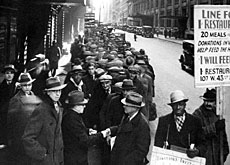
The stock market crash that also hit Switzerland

It is 75 years since the Wall Street Crash triggered a world economic crisis.
The stock exchange crash also had lasting effects on Switzerland, even if these were less visible than in the United States and elsewhere, according to Swiss historian Bernard Degen.
It all began on “Black Thursday”. On the morning of October 24, 1929, a sharp fall in prices sent shares tumbling to record lows.
Shares continued to slump on the following days, which entered the history books as “Black Friday”, “Black Monday”, and “Black Tuesday”. It was the largest stock market collapse the world had experienced.
The crash was the catalyst for the world economic crisis that in the following years pushed countries and millions of people to the edge of ruin.
Hard hit
Germany was the hardest hit country in Europe, with more than six million unemployed in 1932. The crisis created the right conditions for Adolf Hitler to seize power in 1933.
Switzerland did not escape from the effects of the stock market crash and subsequent world economic crisis. The consequences were not as catastrophic but they lasted longer than anywhere else, said Degen, who lectures at Bern University’s Institute of History.
“The domestic economy and in particular the construction industry did quite well at first,” he told swissinfo. “After the First World War, there was a big shortage of apartments in Switzerland and the demand for residential space was high.”
At the time, there was only a minor downturn at the Swiss stock exchange. “It did not play such a big role at first because Swiss companies financed themselves or sought credit from the banks,” Degen said.
Collapse
Degen said that it was only in 1931 that there was a collapse at the Swiss bourse.
Shareholders in Switzerland at that time were mainly richer people and there were “certainly no small shareholders who had put all their savings into shares”.
This was in contrast to the US, where owning shares was something like a “public movement”, in which many people with smaller incomes played along, he said.
Among Swiss banks, it was mainly those institutions with large investments abroad that bore the brunt. They could not bring their money home because, for example, Germany had imposed a moratorium on payments.
“But the cantonal banks, whose creditors were mainly Swiss, did not have many big problems,” Degen said.
Exports hit
Differences were also apparent in the industrial sector. The export oriented watch, textile and metal industries, as well as the mechanical engineering sector, were traditionally hardest hit.
“Many branches gradually recovered but some disappeared for good, take the example of silk ribbon weaving which had been of considerable importance in Basel,” Degen commented.
In pure figures, the crisis in Switzerland reached its peak in 1936 when there were 125,000 people without a job. But unlike the US, where there were masses of people on the streets locked out and unemployed, such scenes in Switzerland were few and far between.
“The unemployed were certainly present in the streets and there are pictures showing queues at the labour offices in Zurich, Basel or Geneva,” the historian said.
And there were also big factory closures, such as Brown Boveri in Münchenstein near Basel.
“But there were no spectacular mass gatherings of jobless because it was mainly the smaller watch or textile industries factories that were affected and these were spread all over,” he said.
As a result, the masses of unemployed were not so evident.
Series of collapses
The stock market crash of 1929 was the prelude to a series of collapses that have confronted investors at irregular intervals.
“When the New Economy bubble burst in 2000, small shareholders were also affected, unlike in 1929,” Degen said.
But today the financial base of investors is larger. “The misery of those affected in the US in 1929 was far greater than in the subsequent crashes,” he added.
swissinfo, Renat Künzi
United States share prices fell by almost 90% between October 1929 and the summer of 1932.
The Dow Jones Index on Wall Street fell from 381 points in September 1929 to 41.22 points in the summer of 1932.
The US unemployment rate in that summer was more than 25%.
The Dow Jones only climbed above the level of 381 points 25 years later.
The New York stock market crash in late October, 1929, triggered a world economic crisis known as the Great Depression.
The jobless numbered in the millions outside the US. Germany alone had six million.
The peak of unemployment in Switzerland was 125,000 in 1936.
Here, the crisis ended aftee the Second World War, with the exception of the arms industry.

In compliance with the JTI standards
More: SWI swissinfo.ch certified by the Journalism Trust Initiative




























You can find an overview of ongoing debates with our journalists here . Please join us!
If you want to start a conversation about a topic raised in this article or want to report factual errors, email us at english@swissinfo.ch.